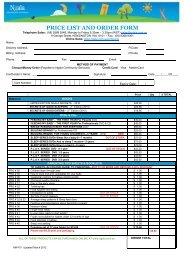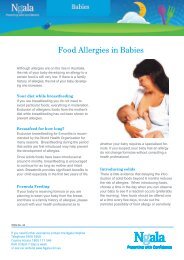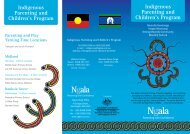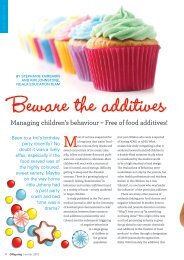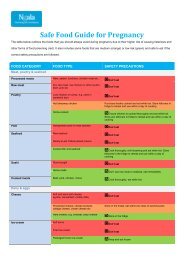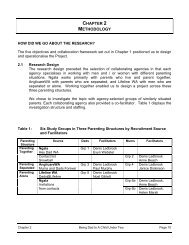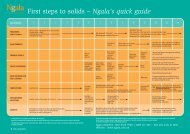Nutrition and Brain Development 6-12 months - Ngala
Nutrition and Brain Development 6-12 months - Ngala
Nutrition and Brain Development 6-12 months - Ngala
Create successful ePaper yourself
Turn your PDF publications into a flip-book with our unique Google optimized e-Paper software.
<strong>Nutrition</strong> <strong>and</strong> <strong>Brain</strong> <strong>Development</strong> 6-<strong>12</strong> <strong>months</strong>Now your baby has reached another milestonebeing ready for solid food! Between 5-7 <strong>months</strong>your baby will begin to be more interested in thepeople <strong>and</strong> objects in his environment, includingwhat those people are eating. He may lookintently at food going to your mouth, maybedrool or make a grab for it. These are all signs ofreadiness to graduate to solid food tocomplement their dependence on milk. Bodywise these instincts are driven by physicalmilestones like the ability to make chewingmotions <strong>and</strong> the fact that the stomach <strong>and</strong>intestines are mature enough to deal with foodsother than milk which is easiest to digest. <strong>Brain</strong>wise, the need for extra elements like iron is animportant step in building the capacity of thebrain <strong>and</strong> an oxygen rich blood supply. Greatsources of iron at this stage include red meat,eggs, <strong>and</strong> tuna, salmon <strong>and</strong> of course breastmilk <strong>and</strong> appropriate formula milk.Your child's brain is also seeking out new taste<strong>and</strong> smell sensory information. This is a greatwindow of opportunity to expose your child tonew foods, even ones you are not particularlyfond of. The brain is constantly evaluating theinformation it receives through the senses, <strong>and</strong>food does not just provide sensation through thenose <strong>and</strong> mouth. Babies need to touch, squash,poke <strong>and</strong> smear the food to get a better idea ofwhat to expect from this new stuff before it getsto their mouth. Don’t worry about the mess;babies as soon as they can manipulate items intheir h<strong>and</strong>s to mouth are able to experimentwith appropriate pieces of food. Examples likegripping a piece of bread, squeezing a sectionof banana, <strong>and</strong> grasping a grain of rice betweenfinger <strong>and</strong> thumb. All these experiences teachthem about texture, hardness, slipperiness,softness, stickiness, <strong>and</strong> dryness.Even though solid food is an exciting newexperience, the brain <strong>and</strong> body growth is stillheavily dependant on breast or formula milk.This is because the fats <strong>and</strong> protein in the milkare giving the correct balance of macro <strong>and</strong>micro nutrients needed at this crucial stage ofbrain growth. Breast milk contains a relativelylarge proportion of cholesterol <strong>and</strong> saturatedfat. This is fantastic ‘brain food’. Connectionsmade between brain cells, <strong>and</strong> indeed all cellsmembranes of the body, depend on cholesterolto ‘insulate’ the fibres (axons) to effectivelycommunicate. The brain itself is over 60% fatsin weight <strong>and</strong> the relatively high amount inbreast milk reflects the importance of braingrowth in the human baby compared to othermammals.PRG No. 84
What can parents do?Let your baby explore their food as well as youfeeding themLook out for foods that are rich in iron afterthe first few weeks of introducing solids –especially if your baby was premature.Continue to breastfeed for as long as possibleto reap the benefit of the brain building propertiesof breast milk (The WHO recommendsbreast feeding until about 2 years).Avoid giving your baby ‘low fat’ foods as allnatural fats are great for brain growthMonitor your baby’s environment for toxichazards. Wash all fruit <strong>and</strong> vegetable skins orremove peel. Avoid toxic cleaning agents,sprays or even air fresheners <strong>and</strong> stay awayfrom fumes like heavy traffic, smokes, gardensprays. These chemicals can impact your smallbaby more than a fully grown adult.Watch out for what your baby licks, eats orsucks. Some paint can still contain lead <strong>and</strong>many plastic baby items contain BPA (BiphenylA) which is a type of chemical which can havehormone disrupting effects. Buy toys made ofnatural substances <strong>and</strong> use china ware overplastic bowls spoons <strong>and</strong> cups.ReferencesEnviron Health Perspect. 2011 July 1; 119(7): 989–996. Most Plastic Products Release EstrogenicChemicals: A Potential Health Problem That CanBe Solved Chun Z. Yang, 1 Stuart I. Yaniger,2 V.Craig Jordan, 3 Daniel J. Klein,2 <strong>and</strong> George D.Bittner 1,2www.med.yale.edu/obgyn/pdfashingtonpost_4sept08.pdfJ Lipid Res. 2010 September; 51(9): 2489–2503.doi: 10.1194/jlr.R006338 PMCID: PMC2918434©2010 by the American Society for Biochemistry<strong>and</strong> Molecular Biology, Inc. Genetic connectionsbetween neurological disorders <strong>and</strong> cholesterolmetabolism Ingemar Björkhem, 1* Valerio Leoni, †<strong>and</strong> Steve Meaney §ORIGINAL RESEARCH COMMUNICATIONS: Evidenceof altered central nervous system developmentin infants with iron deficiency anaemia at 6<strong>months</strong>: delayed maturation of auditory brainstemresponses M Roncagliolo, M Garrido, T Walter,P Peirano <strong>and</strong> B Lozoff<strong>Development</strong> al Neurophysiology Unit, Institute of<strong>Nutrition</strong> <strong>and</strong> Food Technology (INTA), Universityof Chile, Santiago.



